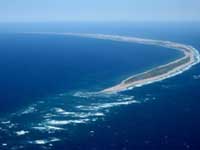 This week Sable Island became the Canada’s newest national park. Almost three hundred kilometers out into the Atlantic off the coast of Nova Scotia, it is a scimitar shaped sandbar which seems to have no business being there at all. It is 44 km long but never more than 2 km wide. It also happens to be on the great circle route, the shortest sailing distance from Europe to New England. Even in good weather, the low-lying island is hard to see and, as it lies where the Labrador current collides with the warm water of the Gulf Stream, is often shrouded in fog. The island has been the graveyard of at least 350 ships since it was discovered around 1520. The first documented ship to come ashore on Sable Island was Sir Humphrey Gilbert‘s flagship Delight in 1583. The last wreck was the yacht Merrimac in 1999. The island has earned it’s nickname, “the Graveyard of the Atlantic.”
This week Sable Island became the Canada’s newest national park. Almost three hundred kilometers out into the Atlantic off the coast of Nova Scotia, it is a scimitar shaped sandbar which seems to have no business being there at all. It is 44 km long but never more than 2 km wide. It also happens to be on the great circle route, the shortest sailing distance from Europe to New England. Even in good weather, the low-lying island is hard to see and, as it lies where the Labrador current collides with the warm water of the Gulf Stream, is often shrouded in fog. The island has been the graveyard of at least 350 ships since it was discovered around 1520. The first documented ship to come ashore on Sable Island was Sir Humphrey Gilbert‘s flagship Delight in 1583. The last wreck was the yacht Merrimac in 1999. The island has earned it’s nickname, “the Graveyard of the Atlantic.”
To see a map of the ships wrecked on the island click here – The Graveyard of the Atlantic.
Sable Island is also the home to upwards of 400 feral horses living wild on the dunes. Some say they horses were brought there by Rev. Andrew LeMercier, a French Huguenot priest from Boston attempting to colonize the island in 1738. Others credit Thomas Hancock, the uncle of John Hancock, signer of the Declaration of Independence. As LeMercier and Hancock hailed from Boston during the period, both may have been involved in the importation of the horses. For photography of Sable Island’s horses click here.
Sable Island is also well known to radio operators. In 1901, Guglielmo Marconi chose the island as the site for a wireless station for transatlantic communication.
